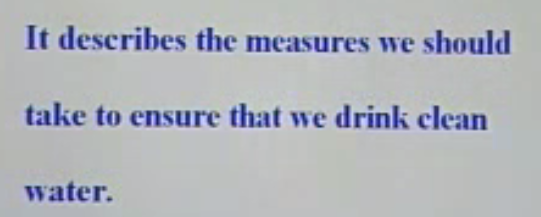Lesson 38 Water and the traveller 水和旅行者
Contamination of water supplies is usually due to poor sanitation close to water sources, sewage disposal into the sources themselves, leakage of sewage into distribution systems or contamination with industrial or farm waste. Even if a piped water supply is safe at its source, it is not always safe by the time it reaches the tap. Intermittent tap-water supplies should be regarded as particularly suspect. Travellers on short trips to areas with water supplies of uncertain quality should avoid drinking tap-water, or untreated water from any other source. It is best to hot drinks, bottled or canned drinks of well-known brand names -- international standards of water treatment are usually followed at bottling plants. Carbonated drinks are acidic, and slightly safer. Make sure that all bottles are opened in your presence, and that their rims are clean and dry.
Boiling is always a good way of treating water. Some hotels supply boiled water on request and this can be used for drinking, or for brushing teeth. Portable boiling elements that can boil small quantities of water are useful when the right voltage of electricity is available. Refuse politely any cold drink from an unknown source.
Ice is only as safe as the water from which it is made, and should not be put in drinks unless it is known to be safe. Drink can be cooled by placing them on ice tather than adding ice to them.
Alcohol may be a medical disinfectant, but should not be relied upon to sterilize water. Ethanol is more effective at a concentration of 50-70 per cent; below 20 per cent, its bactericidal action is negligible. Spirits labelled 95 proof contain only about 47 per cent alcohol. Beware of methylated alcohol, which is very poisonous, and should never be added to drinking water.
If no other safe supply can be obtained, tap water that is too hot to touch can be left to cool and is generally safe to drink. Those planning a trip to remote areas, or intending to live in countries where drinking water is not readily available, should know about the various possible methods for making water safe.
Q:

A:

参考译文
水源的污染通常是由于接近水源的地方卫条件太差而造成的:污水排入水源,污水渗入给水系统或工农业污水造成污染。即使管道供水系统在水源处安全的,等水到达龙头时就不一定总是安全的了。断断续续的水管应该被视为是非常可疑的。
短途旅行到水质不保险的地区时,应避免饮用水龙头的水或未经处理任何其他来源的水。最好仅饮用开水,名牌瓶装或罐装水 -- 装瓶厂通常遵循国际水处理的标准。碳酸饮料是酸性的,就更安全一些。确保瓶子是当你面开启的,瓶口清洁干燥。
烧开一直是水处理的一种好办法。有的酒店根据要求可提供开水,这些开水可用于饮用和刷牙。如果有相配的电压,可以煮少量水的便携式热水装置是有用的。应谢绝任何不明来源的冷饮。
冰块只有当制造冰块的水安全时才是保险的,只有知道冰块安全时才能加入饮料。可以把饮料置于冰块之上来冷却,而不是把冰块加进饮料之中。
酒精可能是医学上的消毒剂,但决不可用来消毒饮用水。乙醇的浓度为50%至70%时比较有效,浓度低于20%时,杀菌能力基本上就不存在了。强度标为95的酒中含有47%的酒精。要提防甲基化酒精,那是剧毒的,永远不能掺入饮用水。
如果没有其他安全的饮用水,水管中流出的烫手的水可以留下来冷却。这种水一般是安全的。那些计划去偏远地区旅行,或在饮用水不现成的国家居住的人,应该知道如何使水适于饮用的各种办法。